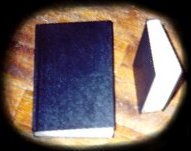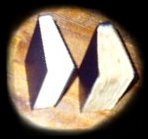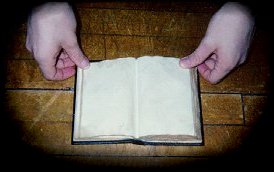


"The heavy old book was bound in thick black leather, much cracked and flaking with age. It was sealed with hinges and a lock of rust-eaten iron, in the manner of books printed in Europe during the 17th century. I opened it gingerly, and was appalled at the noxious miasma of decay that arose to my nostrils from the withered, stained, and yellowed pages; nevertheless, I had come too far to hesitate now. Mastering the involuntary spasm of nausea that welled up in me as I breathed in the almost palpable reek of corruption that arose from the ancient and moldering tome, I pored over the thickly printed pages."
- --The Horror in the Gallery, Lin Carter
There are of course, many ways to make a Mythos Tome. What I am going to demonstrate here is simply the method I used (If you are interested in binding your own book, take a moment to read George Bursuss' experiences in Blasphemous Whispers).
I recommend starting with a blank book. You can then either buy or make a cover for it. Remember, prior to the 19th century, books came loose and had to be bound by hand. What your cover looks like is completely up to you. In The Case of Charles Dexter Ward the Necronomicon was concealed behind the title Qanoon-e-Islam. Look in the Necronomicon Cover Gallery for more cover ideas.
However, I recommend buying a leather covered journal from Oberon Design Inc. They are located in Sonoma County, California, and their journals can be found in most good bookshops.


They come in 9 different colors with leather tooling in either Celtic, Mystic, Floral, Nature or Art Nouveau styles. I chose a red Celtic pattern.
They also come in two different sizes, 4" by 6 1/2" and 5 1/2" by 8 1/2". These aren't cheap, the smaller size retails at about $40, and the larger at $50.  However the finished product is well worth it.
However the finished product is well worth it.
If you don't want to buy the leather jacket, don't worry! Since these instructions only concern the blank book inside the jacket, you can just as easily buy that (it retails for $6 to $10 depending on the size).
For this project you will need:
-
1 book (see above)
scissors or knife
1 sponge
1-2 cups of instant espresso (other forms of coffee or tea can be substituted)
3 cups of hot water
1 bowl
old newspapers
1 hair dryer
rubber gloves (optional)
8-10 pieces of plastic bag cut to the dimensions of the journal (optional)
1-3 ink pens (preferably brown)
You will want to clear off a work space before beginning, as this can get messy. Cover your table with lots of newspaper. Do this in a well ventilated area, since there will be lots of dust.
Using the edge of the scissors or knife roughen up the edge of each page. Take a few pages at a time and really work them. Rip small sections out of the edges and off the corners of the pages as well. This will simulate wear and tear on the book.
The pages of books used to come attached and would have to be cut before they could be read. Roughening the edges of your book will effectively simulate this look.
Now that you have your book "roughed up", you can begin aging it.
I recommend using Folger's® instant espresso; it stains really nicely and smells great! However, any kind of coffee or tea could be used. Mix with hot water in the bowl.
Take the sponge and stain each page with the coffee. If you don't want your fingers to be stained a dubious brown, wear rubber gloves.
It's a long and tedious process, but if you do it for a few hours at a time you can complete it in a weekend.
Be aware that this aging process may cause an increase in the width of your book. As long as your book cover has a clasp, this won't be a problem.
aware that this aging process may cause an increase in the width of your book. As long as your book cover has a clasp, this won't be a problem.
When I first started staining my book, I didn't have access to a hair dryer to dry my pages. So, I stuck pieces of a plastic bag between the pages so they wouldn't stick. The plastic bag's wrinkles created really interesting patterns on the pages (example). When I finally got access to a hair dryer, I continued to use the plastic sheets and did batches of ten pages at a time. If you want a more even look, I recommend drying one page at a time.
Handy Hint #1: Do NOT use the hand dryers you see in public bathrooms. Apparently if used continuously for too long they break. I busted two in my dorm before I figured that one out....
So now your book is aged. What should go on the inside?

For your text I recommend using brown ink pens. While books were never printed in brown ink, it captures that aged ink look better than black or blue. For my book I used Sanford® brand Vis-ą-Vis® Wet-Erase Extra Fine Point pens. they last long and are cheap ($1.25 each). Most art supply stores carry them.
Your first decision needs to be what language your text will be in. I opted for Latin in my book. I copied Latin texts into my book, replacing personal and place names with Mythos equivalents. One of the bonuses of this approach is that the mystique of the book is not ruined by trying to read it.
If you want to use English you will have a much more difficult task as your book will have to stand up to much closer scrutiny. I recommend buying Chaosium's Necronomicon, it has a number of texts that would make perfect filler for a book. Also look through Mythos stories by H.P. Lovecraft, August Derleth and Lin Carter; they all quoted quite extensively from Mythos texts. Also, the NetherReal is compiling as many passages as possible from Mythos texts; when it is finished this will be an invaluable resource.
You need to develop a style of writing that fits with the language of your book. I chose a blocky, almost rune-like style to suggest that my book was copied by an ancient cultist from another work for his own purposes.
I highly recommend that you start your text in the middle of your book. It will take you a little while to find your style, and it would be a shame to mess up the beginning of your book.
Next you will need to consider how you will illustrate your book.
The Call of Cthulhu source book from Chaosium is filled with designs and images to inspire you.
I also recommend looking for a copy of Pictures From a Mediaeval Bible (sic) by James Strachan, it is filled with Medieval woodcuts that can be copied and changed to depict Mythos creatures and locations.
Look through issues of gaming magazines like White Wolf for inspiration.
Robert McLaughlin in his book Cthulhu Live recommends looking at those cheap Necronomicon paperbacks sold in the occult sections of bookstores for inspiration.
The last step is to detail the book. This can be done as you go along, or when you have finished. The idea is to make the book look as old and used as possible. Disregard any suggestions that don't fit with your vision of your book.
Rip a few pages out of the book.
Consider adding notes in a different language and color ink than the book's text. I added some Japanese in black ink to some of the pages of my book which were too bare.
Try spilling ink on a page or two.
Rub some dirt on some of the pages.
Water-stain some of the text on a page.
Handy Hint #2: Don't let a nose bleed go to waste. NOTICE: I am NOT suggesting that you actually cut yourself to add blood to a text, but if you've got a nose bleed, why waste it? It adds to the sinister history of your blasphemous tome like nothing else can. Here's an example from my Necronomicon.
Check out the Blasphemous Whispers section for more suggestions!

There! By now you should be prepared to try making your own Mythos Tome. Understand that this is not an easy undertaking; it can take literally months of work to create. However, it is well worth it when it is done. Good luck!
Have you made anything you would like to show off? Email me at: xn@geocities.com

Cthulhu Live Robert McLaughlin ISBN 56882-041-0 Chaosium Inc.
Pictures From a Mediaeval Bible James Strachan Beacon Press
The Necronomicon Robert M. Price, Series Editor ISBN 1-56882-070-4 Chaosium Inc.
